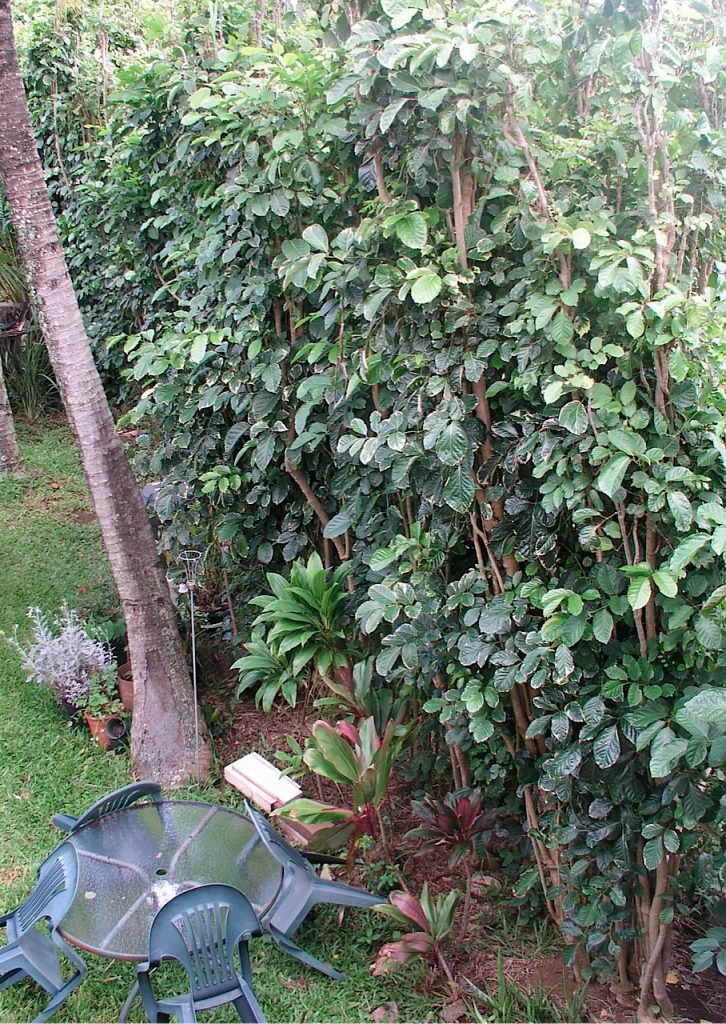The Barefoot Gardener: Dealing With Wind

A row of mature variegated panax shelters the author’s yard from damaging winds. PC: J.M. Buck
How can you grow a successful garden in windy conditions on the Big Island?
Everyone knows the old proverb “Nothing can be said to be certain, except death and taxes.”
But anyone who has been in the Hawaiian Islands for a while knows that isn’t completely accurate—if you live in or near North Kohala, strong trade winds are a sure thing.
I remember my first time planting in a place with constant wind. What a wake up call. I planted bougainvillea along the driveway and two years later it was the same size it was when I had planted it. I thought I had discovered a new way to grow bonsai trees.
The simple fact was that the strong trade winds had stunted the plants. Not only that, one side had a strange trapezoidal shape.
Yes, our island winds can definitely be a challenge for even the most knowledgable of gardeners, but don’t worry, it can be accomplished if you are willing to be creative and spend a little extra time creating a garden-friendly environment.
Solutions for Windy Environments
Plant Close to Your House
If the leeward side of your house has a sunny spot close to the structure, that’s a good place for a garden plot. If you reside in a post and pier home, block off the wind blowing underneath the house with plywood, reed fencing (you can get this at any hardware store and it is easy to cut with sharp scissors), or coconut fronds. If you are really motivated, woven ti leaf is an excellent windbreak.
Build a Wind Fence
There’s several ways to accomplish this solution that fit every price range.
The Really Frugal Way (aka: The I Just Moved or Bought Property or Am Out of Work and I’m So Broke I Can’t Afford to Pay Attention Way)
What I did on the property I spoke of in the opening paragraph was build a wooden support frame and tied coconut fronds to it. Now, at the time, I basically had no extra funds but was determined to make an effective windbreak and grow a great garden. So I went around to every major construction site that was tearing down their windbreak fences and begged wood to recycle. I sunk 4x4x8s two feet deep every eight feet on center after treating the subterranean length with a substance to prevent post rot. Then I affixed 2x4x8s along the top and bottom of the posts. On the lower 2x4s I allowed eight inches clearance above the ground for weed whacking and airflow. I used 80-pound test monofilament to tie coconut fronds to the 2x4s, making sure that they overlapped sufficiently. It looks cool and works exceptionally well, but that’s a lot of work, isn’t it?
For Those Who Have a Job, Some Extra Time, and Have to Budget Carefully
Here’s an easier way that costs under $100: Get tall T-posts at a farm supply or hardware store, pound them in every 6 to 8 feet, run heavy gauge wire on the top, middle and bottom of the posts and zip-tie on reed fencing.
For Those Who Have a Really Good Job and Little Time
Have a chainlink fence installed around your prospective garden plot then slide in those little vinyl strips that people in Mainland suburbs use for privacy. This is very good for blocking the wind as well as the view if you want to garden in the nude. C’mon, we live Hawai‘i, yeah?
For Gazillionaire Movie Stars, Heirs to Hemorhoidal Ointment and Breakfast Cereal Fortunes and The Like
Hire a structural engineer to figure out the logistics of the concrete and stucco garden surround. Hire an environmental engineer to determine if there will be any runoff that might affect the surrounding ecology. Hire a landscape designer to assure that your garden will not only provide full production year-round, but will also exhibit a tasteful and complementary color palette to the ocean-view background. Finally, be sure to hire a marketing consultant to sell your produce. Hey, you think I’m kidding, but this actually happens! (I won’t name names).
The Professional Farming Way
If you are going to be growing produce for sale and for the long-term, you will want to plant a windbreak. Panax (Polyscias guylfoilei) is the preferred windbreak here in the islands. It will easily take from cuttings up to 8 feet long and is an evergreen, so will protect your garden year-round. Panax plants grow rapidly, and they can be backed up with a row of ironwood trees (Causarina). If you plant ironwood, be sure to plant them well away from a garden and only as a backup windbreak, as the fallen needles inhibit plant growth. Bamboo is also a good windbreak; however, be sure to use only a Bambusa variety (it’s a clumper, not a runner) Use bamboo with the same caveat as ironwood, as the high silica content of the fallen bamboo leaves retard plant growth as well.
Happy gardening!













